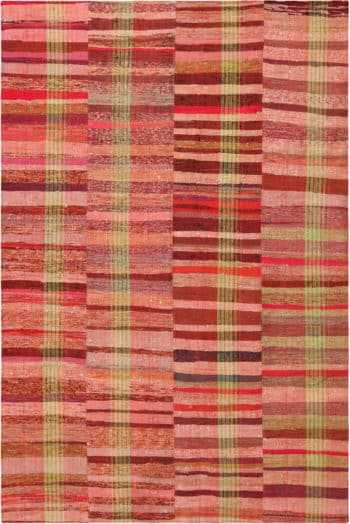Modern Geometric Swedish Inspired Rug 61074
Decorative Neutral Geometric Modern Swedish Inspired Design Rug, Flat Weave Origin: Modern Indian, Circa: Modern – This modern rug from India brings you the best of two worlds: the consistent high quality standard of the Indian rugs with the cool style of our highly sought after modern Swedish design area rugs. The overall pattern is one of repeating pastel tiles of similar squares. While the neutral rug colors are soft, pale gray-blue, and light mauve, the entire composition is composed of gentle tints providing a subtle atmosphere of peace.
In addition to the gentle palette, the carpet offers more. Every square differs slightly from the others but together their structure evokes the organization and solidity of cadets in formation. Each square is bounded by three borders, each repeating the ground color but varying slightly in weave and color pattern. The tight tweedy weave of slubby abrash invites you to run your fingers over it.
In the 16th century, Emperor Mughal Akbar was expanding his empire. He welcomed the cultures and religions of the many peoples in his realm, bringing artisans, musicians, poets, and scholars to his court. Skilled Persian rug weavers came, too, and helped him establish workshops. He trained prison inmates to weave rug as well. The evolving Indian style blended decorative Persian patterns with exotic florals and animals.
Later rulers, including Shan Jahan, the creator of the Taj Mahal, lent their ethereal magic to carpet design. The Indian carpet industry flourished. In its heyday, special pieces commissioned for royal courts were woven from the finest silks and wool from sheep and cashmere goats, glinting with golden thread and studded with gems.
Meanwhile, traveling Viking merchants had been bringing Oriental rugs to the Scandinavians from Russia and Byzantine lands since the 9th and 10th centuries. Swedish weavers adopted the Ghiordes knotting process from Anatolia, crafting flatwoven pieces with a high knot density. At first, mostly fishermen and sailing men used the rugs for bedding, but their attractiveness was universal. As humans do, Scandinavian artisans copied Oriental motifs and later incorporated their own unique styles. The demand for exotic and luxurious handwoven high end carpets increased, spreading to Europe’s royal courts, wealthy patrons, and houses of worship.
In 1947, when India gained independence, a rebirth of handcrafts swept the ancient new nation. To broaden its base, India incorporated the styles of other cultures just as Mughal Akbar had done so many centuries before. Groups of women learned the art of weaving just as their sisters had been doing in Scandinavia.
Today Swedish-style room-sized area rugs handwoven in India offer you a unique art genre. Natural dyes and high-quality yarns are used to create organized, almost rhythmic designs. Upon closer examination, each panel reveals abrash variations in color to the savvy observer. The rectilinear design is reminiscent of a window, a dwelling, a fence, or a village. Although one can feel the coolness of reindeer in the snow, at the same time a subtle underlying warmth provides assurance of peace and security.


















